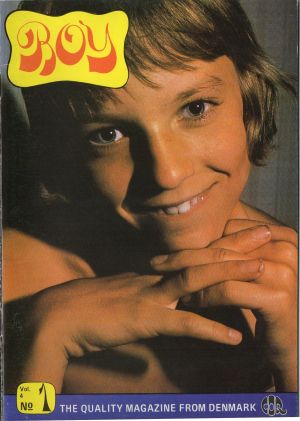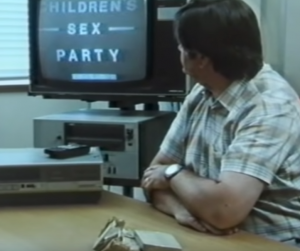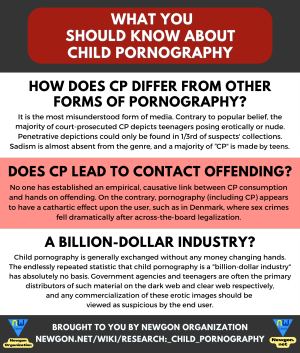One of our staff members is contributing considerably to a News Archiving service at Mu. Any well educated (Masters, PhD or above) users who wish to make comments on news sites, please contact Jim Burton directly rather than using this list, and we can work on maximising view count.
Child Pornography: Difference between revisions
The Admins (talk | contribs) No edit summary |
The Admins (talk | contribs) |
||
| Line 64: | Line 64: | ||
==Liberalization attempts== | ==Liberalization attempts== | ||
Criminalization of CP/Youth Erotica [[Wikipedia:Child_pornography#History|took place mainly in post-70s era]]. Subsequent attempts at liberalization have been few and far between. | Criminalization of CP/Youth Erotica [[Wikipedia:Child_pornography#History|took place mainly in the post-70s era]], sometimes gradually. Subsequent attempts at liberalization have been few and far between. | ||
===Hungary=== | ===Hungary=== | ||
Revision as of 18:38, 22 September 2022




"Child Pornography" (CP) is a broad term which refers to nude, sexual, or pornographic depictions of children, minors, or persons under the age of consent. The definition varies across jurisdictions, often with regard to moral and cultural sensibilities such as perceptions of nudity or appropriate ages for sexual activity. There are also a number of specific crimes related to child pornography; for example - "making" images and "distributing" them. In many cases the laws pertaining to different CP crimes use different labels and the term "Child Pornography" itself remains a colloquial, catch-all term.
In the 00s and early 10s, it was common for western regulators and law enforcement agents to claim that the viewing of "Child Pornography" was an act of abuse against the "child" featured in the material, regardless of whether or not they were aware of this. More recently, preventionist prohibitionists such as Prostasia Foundation have even described this argument as an understatement.[1] Those in favor of liberalizing statutes will sometimes point to this "voodoo abuse" trope as evidence that prohibition of such material is founded upon a "metaphysical" argument. In some cases, American judges have felt the need to apologize for unnecessary and draconian "mandatory minimum" sentences against men who pose no risk to society.[2]
Etymology
Etymologically speaking, the term "pornographos" referred to depictions of harlots (prostitutes) in Ancient Greece. Labelling child images as pornography (calling them whores, essentially) contradicts the thought process that children cannot consent to sex. Prostitutes must by definition by consensually selling sex, otherwise it is rape and not prostitution. People who are sold as objects without their consent are called sex slaves, not prostitutes.
Nature and History of "CP"
- See also Research: Child Pornography and Research: Double-Taboo CSA.
Most people would intuitively assume that known prosecutions of "CP" select in favor of the "worst kind" of material and against "borderline" collections. This is not true, however, with well known cases such as LS series, Webe Web, Azov and the formerly legal material from the 70s featuring "teen nude or semi-nude modeling" type material with provocatively posed adolescents.
Formerly legal content
Color Climax, a well known Danish porn company still in business, was one of the few studios openly advertising in the seventies that they produced child pornography videos (Wikipedia source), its "Lolita" video series featured young girls with men, women, or other children, some of the titles produced by Colour Climax included "Incest Family", "Pre-Teen Sex", "Sucking Daddy" and "Child Love".
COQ International was another Danish company producing child pornography, they specialized in boys, one of their magazines, "Piccolo", contained a mix of hardcore and softcore child porn photographs, another magazine called "Boy", consisted of mere nudity, they also produced another magazine called "Uncle Joe".
Other child porn European productions were "Anna and her Father" and "Bambina Sex" (Danish). In the Netherlands a magazine with prepubescent girls called "Lolita" was published. Child porn magazines had very little text consisting of sexual caption on the photos, most pages were printed in black and white, but the frontpage was always in colour.
Up until recently, most of the hardcore child pornography found on the Internet consisted of low quality grainy photographs from scans of those magazines produced 40 years ago, there is no commercial hardcore child porn company, all that can be found is old material or small series of amateur footage that given the distribution problems never really spreads widely.
Self-made and "capped" material
As mentioned in our research articles, most material in circulation nowadays is self-made.
It is a widely known "problem" that teens and sometimes even preteen minors will strip and display of their own accord during livestreams on well-known sites such as Omegle and historically YouNow. Since these sites have plausible legitimacy, a "safety in numbers" effect can be observed in which any illegal activity taking place goes under the radar. In some cases, enterprising youths will actively seek to monetize their content, as was the case with the now defunct KidsChat.[3]
That material which does circulate via the dark web is occasionally "capped" (saved video footage) from the above type of site, with boys being particularly willing to strip and perform when they are lured with video of stripping and masturbating girls and women. Cappers of teenagers are very secretive about sharing their material, often taking measures to prevent it leaving the dark web. When cappers of boys have been approached for comment, they tend to defend this practise as the only available method of producing material in the present environment, adding that it rarely if ever circulates on the clear web.
Politically-correct alternatives and their limitations
Most people who become politically engaged on the topic of "Child Pornography", or prohibited images of minors in general, prefer to use alternative terminology. There is presently no agreement on what form this should take.
"CSAM" (prohibitionist)
More recently, a politically correct term, CSAM (Child Sexual Abuse Material) has come into use, particularly by eliminationists such as INHOPE. However, since most such material is now produced by minors, this term, and the idea that all such material can be eliminated, is inherently problematic and has implications for civil liberties. It should also be noted that most such minor pornographers are in fact teenagers and not prepubescent children, who make up a tiny minority of such material despite being of greater importance to investigators. Some investigations would also appear to contest the idea that the rarer, adult produced "CSAM" necessarily meets widely accepted scientific definitions of "abuse", when it instead only violates legal statutes that were often passed years after the date of production.
The UK's Internet Watch Foundation uses "child sexual abuse imagery",[4] implying that the self-capture of masturbation by people under 18 is "abuse" by a "child" unto him or herself (see prohibited images of children).
"Youth Erotica" (libertarian)
A more accurate term for the genre would be "Youth Erotica", although this, or similar terms have not seen widespread use, due to the legal schemes in most western countries (see Child Pornography Laws, or Wikipedia's piece on the legality of CP).
Law enforcement as distributors
It is relatively common for law enforcement departments to be the primary distributors of "CP". In the famous instance of "Childs Play", Australian police took over a million-user CP forum for 11 months in 2016-2017. During this period, the number of posts containing one or more CP images were said to have more than doubled, from 4500 to over 12,000, many of which were posted by LEOs themselves.[5] The parent of one girl even went so far as to insist that the police officers who circulated images of her daughter should have paid her:
My daughter should not be used as a bait. If they are using her images, then she should be paid or compensated for their use. It is not right for the police to promote these images, says the mother.[5]
It was also found that other federal institutions such as the FBI had similarly taken control of other well-known resources in order to carry out sting operations and distribute malware.[6][7]
A threat to civil liberties?
Corporations and governments have abused CP to increase surveillance and crack down on encryption. Apple, for example, once planned to search every image on their devices without the consent of the owners, only backing down after mass uproar.[8] In 2022, the UK government launched the No Place to Hide campaign, abusing figures and yet largely failing in an attempt to provoke public outrage against the use of encryption.[9][10][11]
Liberalization attempts
Criminalization of CP/Youth Erotica took place mainly in the post-70s era, sometimes gradually. Subsequent attempts at liberalization have been few and far between.
Hungary
In 2007, a bill modifying Hungary's penal code was proposed, which would legalize the production and posession of erotica involving 14 to 17-year-olds. The Justice Ministry said the draft proposal, presented by Hungarian Justice Minister Jozsef Petretei, was in line with European Union norms which give members states the right to regulate the issue at national level.[12]
List
For a comprehensive list of articles, see Category:Child_Pornography.
To avoid confusion of this topic, we constructed a series of articles that relate to this issue:
- Child Pornography Laws - Links to present laws.
- Indecent images of children - UK Laws.
- Research: Child Pornography
- Child Pornography (Wikipedia) - Archive of an old Wikipedia article (Censored article, as of 2008).
- List of MAP-related magazines - Some reference to nudist/erotica titles and banned mail-order video services.
In addition to this, all of the following may or may not be considered child porn:
- Boy Photography
- Girl Photography
- Non-photographic erotica involving minors, including literature and cartoons.
External links
Our research article on CP also contains numerous articles on this topic, including official manipulation of statistics.
- Omegle - One mainstream video chat site said to be a hub of Youth Erotica.[13]
- Hyping up the numbers - Examples of how statistics are manipulated.
- The Cook Report, 1987. Cook confronts "child-pornographers" - Roger Cook investigates the low-level production of CP, at the end of the 80s, when the crackdown was beginning.
References
- ↑ Prostasia Foundation on Harms of "CSAM"
- ↑ Judge Weinstein: NY Times
- ↑ KidsChat archive
- ↑ IWF 2021 Annual Report
- ↑ 5.0 5.1 VG - Investigation into a CP Investigation
- ↑ EFF - Playpen case
- ↑ Vice - Playpen case
- ↑ Prostasia on Apple
- ↑ Rolling Stone - UK No Place To Hide campaign
- ↑ The @ukhomeoffice-funded #NoPlaceToHide campaign claims that “14 million reports” of child abuse may be “lost” if @Messenger implements #endtoendencryption. Here’s a horrible thought … (By Dropsafe)
- ↑ Why we need #EndToEndEncryption and why it’s essential for our safety, our children’s safety, and for everyone’s future #noplacetohide (By Dropsafe)
- ↑ USA Today: Hungary may legalize porn involving 14- to 17-year-olds for home use
- ↑ Omegle: Children expose themselves on video chat site
- Child Pornography
- Official Encyclopedia
- Law/Crime
- Law/Crime: Crime Types
- Censorship
- Prostitution
- Hysteria
- Youth
- TV & Media
- Terminology
- Terminology: MAP
- Terminology: Popular
- History & Events: British
- History & Events: American
- History & Events: International
- History & Events: 1970s
- History & Events: 1980s
- History & Events: 1990s
- History & Events: 2000s
- History & Events: 2010s
- History & Events: 2020s